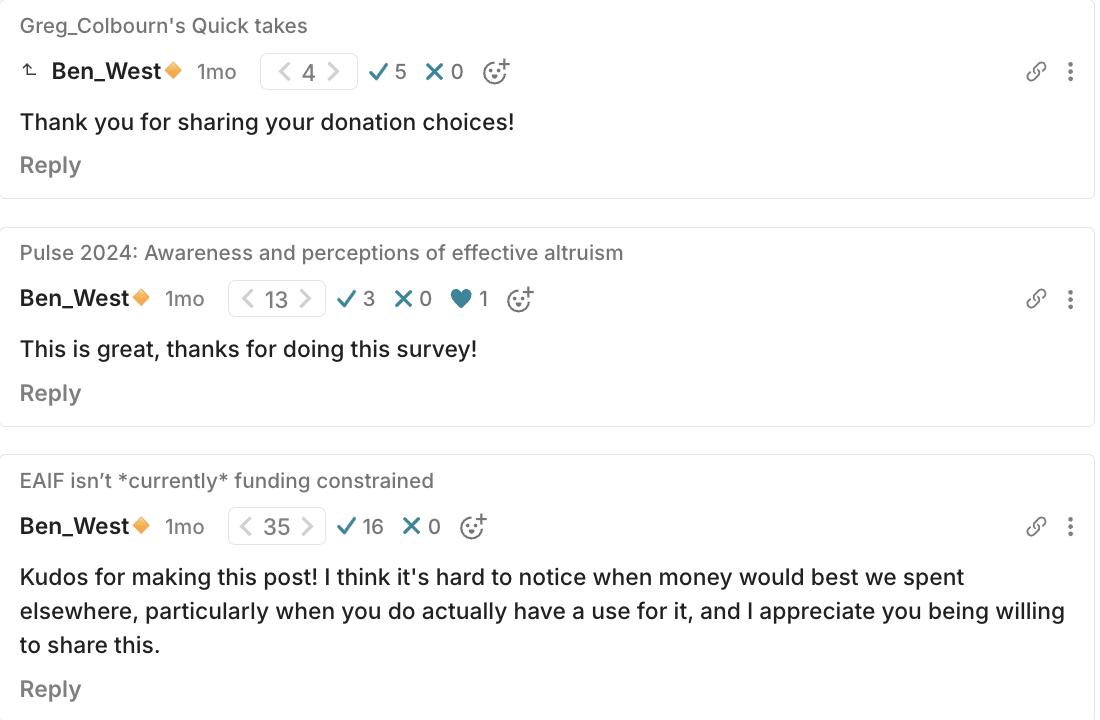I think more people should consider leaving more (endorsed) short, nice comments on the Forum + LW when they like a post, especially for newer authors or when someone is posting something “brave” / a bit risky. It’s just so cheap to build this habit and I continue to think that sincere gratitude is underrated in ~all online spaces. I like that @Ben_West🔸 does this frequently :)

Agree. Nice (truth-tracking) comments seem high-leverage for boosting morale + reducing excessive aversion to forum-posting + countering the phenomenon where commenters are more critical than the average reader (which warps what authors think about their readers).
Do you think that it would be better to just add a helpful or heart emoji to the post instead? I used to leave the same sorts of comments as Ben. These got downvoted occasionally. I interpreted this pattern as being due to people not appreciating these sorts of 'thank you comments'. When emoji react were added, I therefore switched to emoji reacting, as I felt that this would achieve the same outcomes without creating the 'noise' of a 'thank you comment'. However, I could go back to leaving comments if that seems like a better approach.
Reactions seemingly serve that purpose better:
https://forum.effectivealtruism.org/posts/oZff425xLnikfxeGD/pat-myron-s-shortform?commentId=HsadBx85nAggb8Q5T
IMO these two actions have different purposes, and we could use more of both here. :) In particular, I think it's more valuable than one might expect to leave a short comment that includes a bit of gratitude. Even short comments often communicate something that reacts cannot. For example, the last comment in Angelina's screenshot helps enforce good norms in the community.
Agree the bottom comment is significantly more complex than reactions. The top 2 could be reactions
I agree and am guilty of not doing this myself; I mostly only leave comments when I want to question or critique something. So after reading this I went back and left two positive comments on two posts I read today. (Plus also this comment.) Thanks for the explanation and nudge!
Some Alfred workflows (productivity tools)
Alfred is a pretty powerful Mac app which lets you set hotkeys for a lot of things. Here are some workflows I use very frequently that I would recommend others try out. If you have favorite Alfred workflows, I'd love to hear about them in the comments!
For the record, my Alfred app thinks that I have used a hotkey or Alfred expansion on average 9.3 times per day since March 2022.
Kill
I frequently get distracted or overwhelmed by having too many windows / tabs open, and losing track of what I was supposed to be doing. Whenever I notice that I am getting sidetracked, it’s extremely useful for me to have a ‘kill switch’, which just closes down all of my tabs and lets me start over.
I now have a ‘kill’ Alfred hotkey set up to forcibly quit Chrome, Slack, Microsoft suite products, various programming apps, etc., so that I can start again from a blank slate. I use this hotkey multiple times a day on average while working. In theory, if I need to find a Chrome tab again, I can always go into my history / ‘recently closed tabs’ section — but I don’t ever recall needing to do this since installing this hotkey over a year ago.

I used to be the person with 1,000 Chrome tabs open at all times. I now think this is extremely damaging to my attention span and would lightly recommend other people who rely heavily on tabs in their workflow to try out a tab-limiting policy to see if it helps.
Tz
I work on a distributed team and have family around the world, so knowing the current time in a few key timezones is often extremely helpful for coordination purposes. The tz workflow is really nice for this.
I added a ‘tzdetail’ hotkey, which opens up a URL to an external website, displaying the time across the day in major cities in all the timezones I frequently care about. I often use this before booking meetings with colleagues in other timezones, and having it at my fingertips is super useful.

Curl
Sometimes I want to read paywalled articles. I set up a workflow to do this using the ‘curl’ Terminal command which is good for some newspapers. (I do pay for some subscriptions, and am not sure I 100% endorse this, but it is a very valuable service in my life).

Snippets
Alfred also has decent text expander functionality (called ‘snippets’: General > Snippets). I have a bunch of snippets set up to auto-fill my email/s, number, and some generic email responses.
One snippet I use very frequently is ‘date’, which just pastes the current date formatted as YYYY.MM.DD. I use this extremely frequently, to label my Google doc titles with the current date, to jot down the current date in my meeting documents, to comment the date when modifying files, etc. The setup is pretty simple (see screenshot).
Sidebar: I think this format of date is the best for distributed teams, since it is unambiguous worldwide and makes your filenames sortable alphabetically (amongst other reasons).


.
If you have a Mac and don’t mind editing some Bash / osascript code, here’s some of the workflows I use that you can try downloading and playing with (I don’t have capacity to help you debug, sorry!):
Personal scripts (probably needs tweaking to work for you).alfredworkflow
Quick PSA:
- CEA has a public dashboard which contains metrics on most of our projects!
- We’ve just launched a few updates:
- The EA Forum, EAG, and EAGx data now refresh daily.
- This is most relevant for the Forum data, to help answer questions like “what is happening with the Forum ~right now”.
- All other sections are updated on a ~monthly cadence.
- We’ve added data on our community building grants program to the Groups section.
- The EA Forum, EAG, and EAGx data now refresh daily.
Feedback is appreciated as always!
PSA: Based on requests from users (e.g. this), we’ve added a link to a data access request form to the public CEA dashboard (which we update every month).
The form is meant to be a lightweight way for us to understand who is interested in exploring our data further, and we expect to approve almost all requests.
As always, feedback is welcome!
One of my current favorite substacks: this author just takes a random selection of Weibo posts every day and translates them to English, including providing copies of all the videos. Weibo is sort of like "Chinese Twitter".
One of my most consistently read newsletters! H/T to @JS Denain for recommending this newsletter to me a while ago :)
You might like https://www.whatsonweibo.com/ (although it is popular enough you may have already encountered it). If I remember correctly, it is mainly just run by one woman, an academic from... some European country (I can't remember off the top of my head).
How do they find posts? Is it literally randomized from the entire set of posts or is there some kind of selection bias?
(Edit: I read a few posts and it seems like a lot of it is the author inserting their own commentary, with a general focus on hot-button issues, so I'm hesitant to subscribe, though I like the concept)
I don't think there's a lot of author exposition? Maybe you clicked on the pinned post, which on a quick skim seems more exposition heavy than the others? e.g. scrolling through this quickly, it's mostly direct quotes.
I'm sure there's some bias in terms of which posts get selected + which follow up comments get highlighted, and I haven't investigated the author at all. I have no idea how the posts are getting selected, I wouldn't assume this is an unbiased learning-focused news source. This is mostly for fun for me :)




How do they find posts? Is it literally randomized from the entire set of posts or is there some kind of selection bias?
(Edit: I read a few posts and it seems like a lot of it is the author inserting their own commentary, with a general focus on hot-button issues, so I'm hesitant to subscribe, though I like the concept)